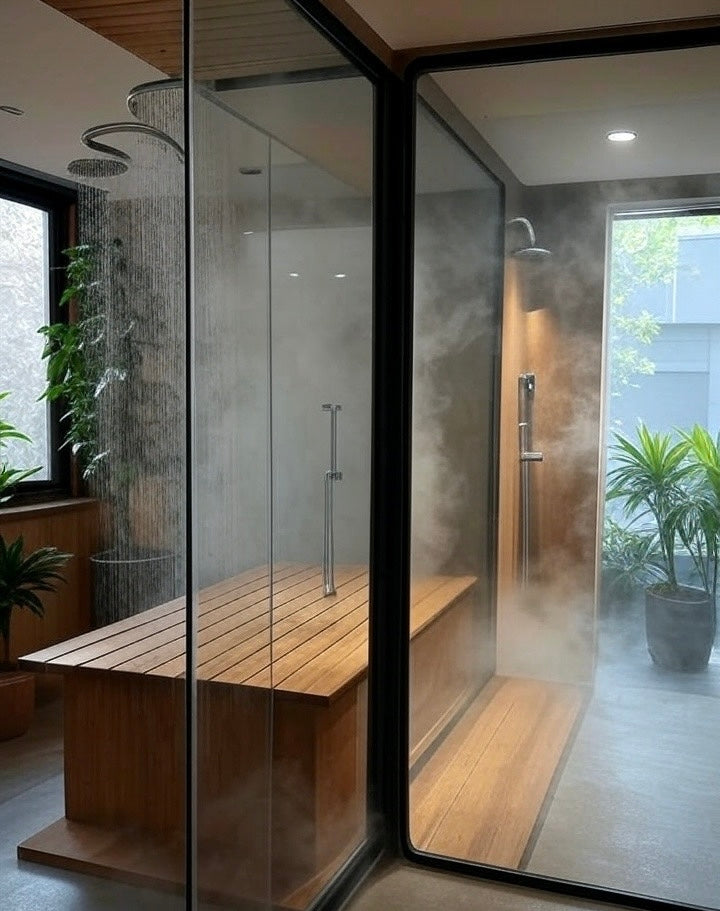Ever stepped into a Steam Room and thought, “Is this doing anything besides making me sweat like I’m in a Steam Bath curry pot?”
Short answer: Yes—it’s doing wonders! From glowing skin to easier breathing, here’s why steam therapy is more than just hot air. Keep reading for the steamy benefits.

The Primary Health Benefits of Steam Rooms
Boosts Circulation and Cardiovascular Health
Steam therapy may help get your blood pumping in all the right ways.
How Moist Heat Affects Blood Flow
When you're in a steam room, the heat causes your blood vessels to widen.
This allows blood to flow more freely around your body.
Improved circulation can leave you feeling warm, loose, and energised.
It also helps muscles recover faster after exercise.
Potential Impact on Blood Pressure
Steam may slightly lower blood pressure due to its calming effect on the body.
However, those with hypertension should be cautious.
It’s always wise to keep sessions short and stay hydrated.
Supports Respiratory and Sinus Health
Steam is known to provide relief for the lungs and sinuses.
Relieving Congestion and Loosening Mucus
The warm, moist air in a steam bath can help clear nasal passages.
It works by loosening mucus and reducing inflammation in airways.
This makes breathing feel easier, especially during allergy season.
Aiding Conditions like Colds and Bronchitis
Steam rooms can ease symptoms of colds and mild bronchitis.
They support the lungs by relaxing tight airways and breaking down phlegm.
People with mild asthma may also find gentle relief—though caution is always needed.
Promotes Skin Health and Appearance
A glowing complexion might just start with a little steam.
Opening Pores and Cleansing the Skin
Steam helps open up pores, which allows dirt and oil to escape.
It can leave your skin feeling cleaner and fresher.
Used regularly, steam may help reduce minor breakouts and even out skin tone.
The Role of Sweating in Detoxification
Sweating helps flush out surface-level impurities.
Though it’s not a major detox pathway, it does promote hydration and surface cleansing.
This leaves the skin feeling soft and revived.
Accelerates Post-Workout Muscle Recovery
After intense movement, steam can offer serious relief.
Alleviating Delayed Onset Muscle Soreness (DOMS)
Steam improves circulation, which can help reduce soreness after workouts.
It delivers more oxygen to tired muscles, aiding in repair.
Even 10 minutes can help loosen stiff areas.
Relaxing Stiff Joints and Muscles
Steam heat can soothe joint tension and soft tissue tightness.
This makes it great for gym-goers or anyone with a physically active lifestyle.
Aids in Stress Reduction and Mental Relaxation
Steam rooms offer a break from your fast-paced world.
The Connection to Cortisol and Endorphins
The warmth encourages the body to release endorphins.
These are your natural feel-good chemicals.
At the same time, stress hormone levels—like cortisol—can drop slightly, helping you feel calmer.
Creating a Mindful Environment
The quiet and enveloping heat of a steam bath promotes mental stillness.
It’s a simple space to breathe, reset, and step away from screen overload.
Understanding the Risks and Key Precautions

Steam rooms are generally safe when used sensibly.
But it’s still important to know the limits.
Potential Dangers and How to Avoid Them
The Risk of Dehydration
Steam causes intense sweating, and that means fluid loss.
Always drink water before and after your session.
Dehydration can lead to dizziness, headaches, or fatigue.
Overheating and How Long to Stay in a Steam Room
Don’t overstay your welcome in the heat.
10 to 15 minutes is usually enough.
Longer sessions can raise your core temperature too much and make you feel faint.
When to Avoid Using a Steam Room
Some people should avoid steam therapy entirely, or get medical clearance first.
Specific Medical Conditions (e.g., heart disease, high blood pressure)
If you’ve got heart issues, low blood pressure, or are pregnant, it’s best to skip the steam—or get advice before using one.
The Importance of Consulting a Doctor
When in doubt, always check with your GP.
Especially if you’re managing a chronic health condition or taking medication.
General Hygiene and Public Steam Rooms
Always use a towel to sit on.
Make sure the steam room you use is regularly cleaned to reduce bacteria and fungi risks.
Steam Room vs. Sauna: What's the Difference?
Both feel like a warm hug—but the heat works differently.
Key Differences in Heat and Humidity
The Environment of a Steam Room
Steam rooms are full of moist heat and run at 40–45°C with 100% humidity.
The air feels damp, and it’s easier to breathe in if you have sinus trouble.
The Environment of a Traditional Sauna
Saunas are dry and run at much higher temperatures—up to 100°C.
This dry heat makes you sweat more quickly, but the air feels hotter and drier.
Deciding Which is Right for You
Comparing the Primary Benefits of Each
Steam rooms are great for skin health, stress relief, and easing breathing.
Saunas are ideal for deep muscle penetration and a stronger sweat.
Matching the Experience to Your Health Goals
Choose a steam bath if your focus is on relaxation, skin care, or easing congestion.
Go with a sauna if you want a more intense sweat or deeper muscle relief.
Conclusion
So, are steam rooms good for you?
Yes—when used properly, they offer a range of physical and mental health benefits. From glowing skin and better breathing to lower stress and muscle relief, steam therapy is a gentle way to care for your body.
Just stay mindful of your time, hydrate well, and enjoy the calm it brings.
Takeaways
-
Steam rooms improve circulation, skin health, and respiratory comfort.
-
They help reduce stress and support muscle recovery after workouts.
-
Limit sessions to 10–15 minutes and always stay hydrated.
-
Avoid steam baths if you have certain medical conditions—check with your GP first.
-
Know the difference: Steam rooms use moist heat, while saunas offer dry, intense warmth.
Let me know if you’d like this turned into a carousel post, email, or short script for a social reel!





